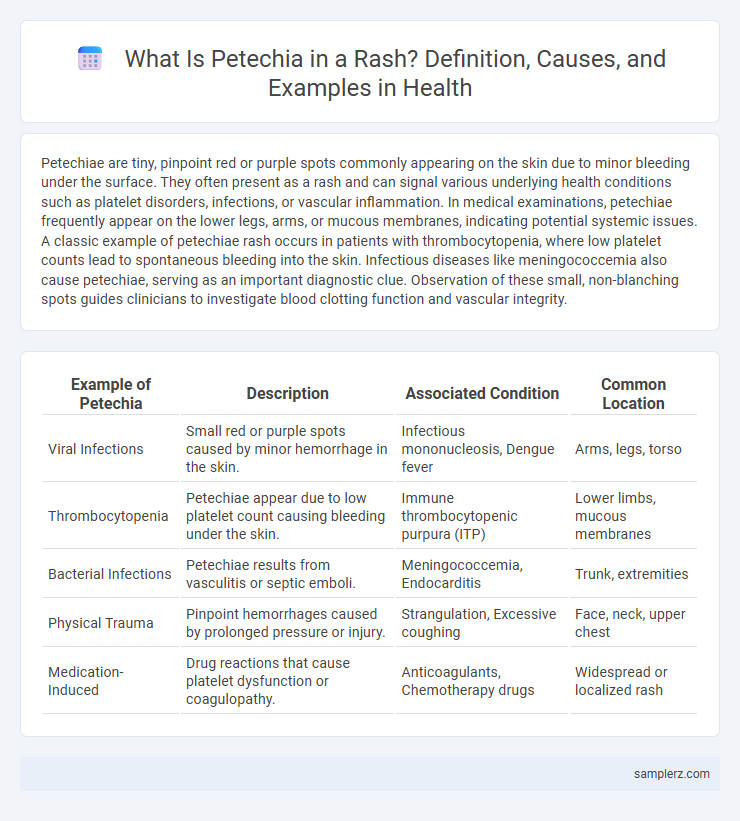Petechiae are tiny, pinpoint red or purple spots commonly appearing on the skin due to minor bleeding under the surface. They often present as a rash and can signal various underlying health conditions such as platelet disorders, infections, or vascular inflammation. In medical examinations, petechiae frequently appear on the lower legs, arms, or mucous membranes, indicating potential systemic issues. A classic example of petechiae rash occurs in patients with thrombocytopenia, where low platelet counts lead to spontaneous bleeding into the skin. Infectious diseases like meningococcemia also cause petechiae, serving as an important diagnostic clue. Observation of these small, non-blanching spots guides clinicians to investigate blood clotting function and vascular integrity.
Table of Comparison
| Example of Petechia | Description | Associated Condition | Common Location |
|---|---|---|---|
| Viral Infections | Small red or purple spots caused by minor hemorrhage in the skin. | Infectious mononucleosis, Dengue fever | Arms, legs, torso |
| Thrombocytopenia | Petechiae appear due to low platelet count causing bleeding under the skin. | Immune thrombocytopenic purpura (ITP) | Lower limbs, mucous membranes |
| Bacterial Infections | Petechiae results from vasculitis or septic emboli. | Meningococcemia, Endocarditis | Trunk, extremities |
| Physical Trauma | Pinpoint hemorrhages caused by prolonged pressure or injury. | Strangulation, Excessive coughing | Face, neck, upper chest |
| Medication-Induced | Drug reactions that cause platelet dysfunction or coagulopathy. | Anticoagulants, Chemotherapy drugs | Widespread or localized rash |
Understanding Petechia: Definition and Appearance
Petechiae are small, pinpoint, non-blanching red or purple spots caused by minor bleeding under the skin, typically appearing in clusters on the lower legs, arms, or torso. These tiny hemorrhages result from broken capillaries or platelet abnormalities and often signal underlying conditions like infections, blood disorders, or physical trauma. Recognizing the characteristic size, color, and distribution of petechiae is crucial for accurate diagnosis and prompt medical evaluation.
Common Causes of Petechial Rashes
Petechial rashes often appear as small, red or purple spots caused by bleeding under the skin. Common causes of petechial rashes include infections such as meningococcemia and viral illnesses like cytomegalovirus, as well as blood disorders like thrombocytopenia and vasculitis. Trauma, certain medications that affect platelet function, and severe allergic reactions can also trigger the development of petechiae.
Differentiating Petechia from Other Skin Rashes
Petechiae are small, pinpoint, non-blanching red or purple spots caused by bleeding under the skin, commonly seen in conditions such as thrombocytopenia or vasculitis. Unlike other rashes like eczema or urticaria, petechiae do not fade when pressure is applied, making the diascopy test a key diagnostic tool. Accurate differentiation involves assessing size, distribution, and response to pressure, alongside clinical history and laboratory tests for platelet counts or clotting abnormalities.
Medical Conditions Associated with Petechiae
Petechiae are small red or purple spots caused by bleeding under the skin, commonly associated with medical conditions such as thrombocytopenia, vasculitis, and infectious diseases like meningococcemia. These pinpoint hemorrhages often indicate platelet abnormalities or vascular fragility and can be observed in disorders like leukemia or sepsis. Recognizing petechiae in rashes is crucial for diagnosing underlying hematologic or systemic conditions requiring immediate medical attention.
How Petechia Develops in Viral and Bacterial Infections
Petechiae develop as tiny red or purple spots caused by minor capillary bleeding beneath the skin, often triggered by viral infections such as dengue fever and bacterial infections like meningococcemia. These infections lead to inflammation and damage to blood vessel walls, causing leakage of blood cells into surrounding tissue. Immune responses and bacterial toxins also contribute to increased vascular fragility and clotting abnormalities, exacerbating petechiae formation.
Petechial Rash in Children: What Parents Should Know
Petechial rash in children appears as small, flat, red or purple spots caused by bleeding under the skin, often indicating serious conditions like meningococcemia or platelet disorders. Parents should recognize that these spots do not fade when pressed, differentiating them from other rashes, and seek immediate medical attention if they notice rapid spread or accompanying symptoms like fever and lethargy. Early diagnosis and treatment are critical to prevent complications associated with petechial rashes in pediatric patients.
Petechia as an Indicator of Serious Health Issues
Petechiae are small, pinpoint, red or purple spots on the skin caused by minor bleeding under the surface, often signaling serious health issues such as blood clotting disorders, infections like meningococcemia, or platelet abnormalities. The presence of petechiae should prompt immediate medical evaluation to rule out life-threatening conditions such as sepsis or thrombocytopenic purpura. Recognizing petechiae as a clinical indicator can facilitate early diagnosis and timely treatment, preventing complications.
Diagnostic Steps for Evaluating Petechial Rash
Petechial rash often presents as small, pinpoint red or purple spots caused by bleeding under the skin, necessitating thorough diagnostic steps to determine the underlying cause. Initial evaluation includes a detailed patient history, physical examination, and laboratory tests such as complete blood count, coagulation studies, and platelet function tests to rule out thrombocytopenia or coagulopathies. Further diagnostic imaging or bone marrow biopsy may be required if hematologic malignancies or systemic infections are suspected.
Treatment Options for Petechiae-Related Rashes
Treatment options for petechiae-related rashes vary depending on the underlying cause, which may include infections, platelet disorders, or vasculitis. Common therapies involve addressing the root condition with antibiotics for bacterial infections, corticosteroids for inflammatory diseases, or platelet transfusions in cases of thrombocytopenia. Supportive care such as rest and avoiding trauma to the affected areas helps minimize further petechial bleeding and promotes recovery.
When to Seek Medical Attention for Petechial Rash
Petechial rash, characterized by small red or purple spots caused by bleeding under the skin, warrants immediate medical attention if accompanied by symptoms such as fever, unexplained bruising, persistent bleeding, or weakness. Rapid evaluation is crucial in cases of suspected infections like meningococcemia or platelet disorders including thrombocytopenia. Early intervention can prevent severe complications and guide appropriate treatment for underlying conditions presenting with petechiae.

example of petechia in rash Infographic
 samplerz.com
samplerz.com